
Hypericum calycinum is a species of prostrate or low-growing shrub in the flowering plant family Hypericaceae. Widely cultivated for its large yellow flowers, its names as a garden plant include Rose-of-Sharon in Britain and Australia, and Aaron's beard, great St-John's wort, creeping St. John's wort and Jerusalem star. Grown in Mediterranean climates, widely spread in the Strandja Mountains along the Bulgarian and Turkish Black Sea coast.

Ophiopogon japonicus (dwarf lilyturf, mondograss, fountainplant, monkeygrass; Japanese: リュウノヒゲ ryu-no-hige or ジャノヒゲ ja-no-hige is a species of Ophiopogon native to China, India, Japan, and Vietnam.
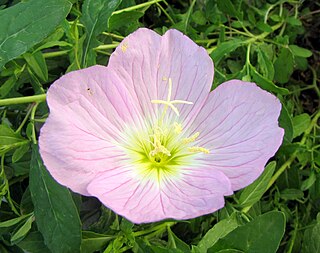
Oenothera speciosa is a species in the Oenothera family known by several common names, including pinkladies, pink evening primrose, showy evening primrose, Mexican primrose, amapola, and buttercups.
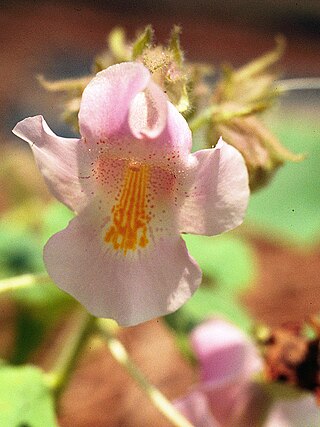
Proboscidea is a genus of flowering plant in the family Martyniaceae, some of whose species are known as devil's claw, devil's horn, ram's horn, or unicorn plant. The plants produce long, hooked seed pods. The hooks catch on the feet of animals, and as the animals walk, the pods are ground or crushed open, dispersing the seeds. The name devil's claw is shared with the South African plant Harpagophytum procumbens.

Cylindropuntia imbricata, the cane cholla, is a cactus found in the Southwestern United States and northern Mexico, including some cooler regions in comparison to many other cacti. It occurs primarily in the arid regions of the Southwestern United States in the states of Kansas, Oklahoma, Texas, New Mexico, Arizona, Colorado, and Nevada. It is often conspicuous because of its shrubby or even tree-like size, its silhouette, and its long-lasting yellowish fruits.
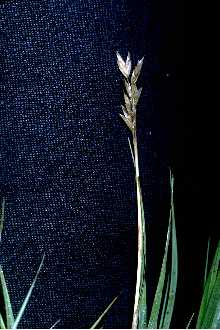
Distichlis spicata is a species of grass known by several common names, including seashore saltgrass, inland saltgrass, and desert saltgrass. This grass is native to the Americas, where it is widespread. It can be found on other continents as well, where it is naturalized. It is extremely salt tolerant.

Actaea rubra, the red baneberry or chinaberry, is a poisonous herbaceous flowering plant in the family Ranunculaceae, native to North America.

Liatris pycnostachya, the prairie blazing star, cattail gayfeather or cattail blazing star, is a perennial plant in the Asteraceae family that is native to the tallgrass prairies of the central United States.

The Sand Mountain blue is a lycaenid butterfly of the "blue" subfamily that is only found around the Sand Mountain Recreation Area near Fallon, Nevada. It is a subspecies of the pallid blue.

Liatris spicata, the dense blazing star or prairie feather, is a herbaceous perennial flowering plant in the family Asteraceae. It is native to eastern North America where it grows in moist prairies and sedge meadows.
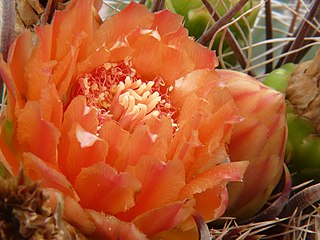
Ferocactus wislizeni, the fishhook barrel cactus, also called Arizona barrel cactus, candy barrel cactus, and Southwestern barrel cactus, is a species of flowering plant in the cactus family Cactaceae, native to northern Mexico and the southern United States. It is a ball-shaped cactus eventually growing to a cylindrical shape, with spiny ribs and red or yellow flowers in summer.

Pseudoroegneria spicata is a species of grass known by the common name bluebunch wheatgrass. This native western North American perennial bunchgrass is also known by the scientific synonyms Elymus spicatus and Agropyron spicatum. The grass can be found in the United States, Canada, and Mexico from Alaska and Yukon south as far as Sonora and Nuevo León.

Liriope spicata is a species of low, herbaceous flowering plant from East Asia. Common names include creeping lilyturf, creeping liriope, lilyturf, and monkey grass. This perennial has grass-like evergreen foliage and is commonly used in landscaping in temperate climates as groundcover. Creeping lilyturf has white to lavender flowers which produce single-seeded berries on a spike in the fall. It is one of the most popular groundcovers in the southeastern United States and areas with a similar climate.

Tigridia pavonia is a species of flowering plant in the iris family Iridaceae. Common names include jockey's cap lily, Mexican shellflower, peacock flower, tiger iris, and tiger flower. This summer-flowering bulbous herbaceous perennial is widespread across much of Mexico, Guatemala, El Salvador, and Honduras. It is naturalized in Ecuador and Peru.

Opuntia humifusa, commonly known as the devil's-tongue, Eastern prickly pear or Indian fig, is a cactus of the genus Opuntia present in parts of the eastern United States, Mississippi and northeastern Mexico.
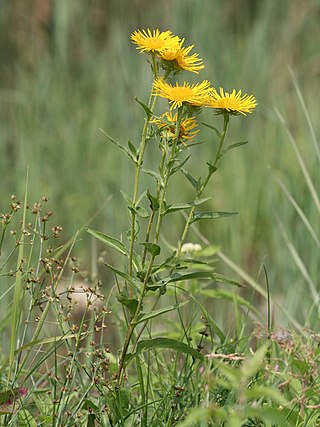
Pentanema britannica, the British yellowhead or meadow fleabane, is a Eurasian species of plant in the daisy family. It is widespread across much of Europe and Asia, and sparingly naturalized in scattered locations in North America.
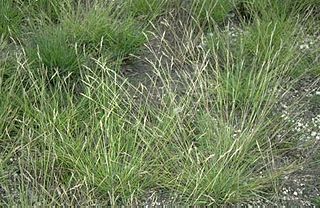
Danthonia spicata is a species of grass known by the common name poverty oatgrass, or simply poverty grass. It is native to North America, where it is widespread and common in many areas. The species is distributed across much of Canada and the United States, and its distribution extends into northern Mexico.
Proboscidea sabulosa is a species of flowering plant in the family Martyniaceae known by the common names sanddune unicorn-plant, dune unicorn plant and dune devil's claw. It is native to Chihuahua in Mexico and New Mexico and Texas in the United States.

Proboscidea louisianica is a species of flowering plant in the family Martyniaceae. Its true native range is unclear, but probably includes parts of the southwestern United States and Mexico in North America. It occurs in other areas, including other regions in North America, Europe, Australia, and South Africa, as an introduced species. It is the most widely distributed species in its family. Common names it shares with other Proboscidea species include devil's claw and unicorn-plant. Names more specific to the species include common devil's claw, ram's horn, aphid trap, Louisiana unicorn-plant, purple-flowered devil's-claw, goat's head, and elephant tusks.
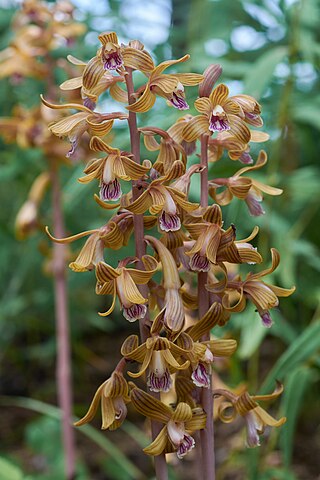
Hexalectris spicata, the spiked crested coralroot, is a terrestrial, myco-heterotrophic orchid lacking chlorophyll and subsisting entirely on nutrients obtained from mycorrhizal fungi in the soil. It is native to Arizona, New Mexico, Texas and Coahuila. It is closely related to H. arizonica and the two are sometimes considered varieties of the same species. Hexalectris spicata is endemic to the southern half of the United States from Arizona east to Florida and north to Maryland and the Ohio Valley.

















